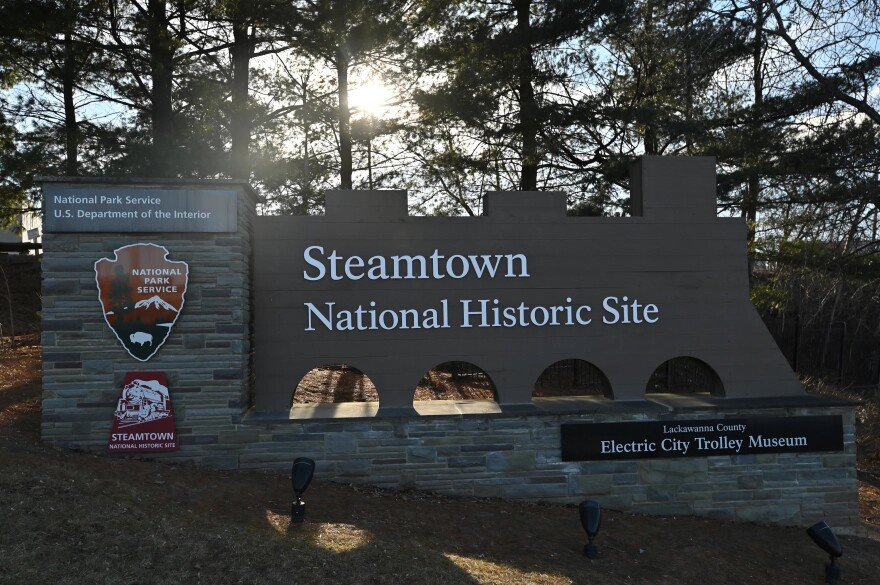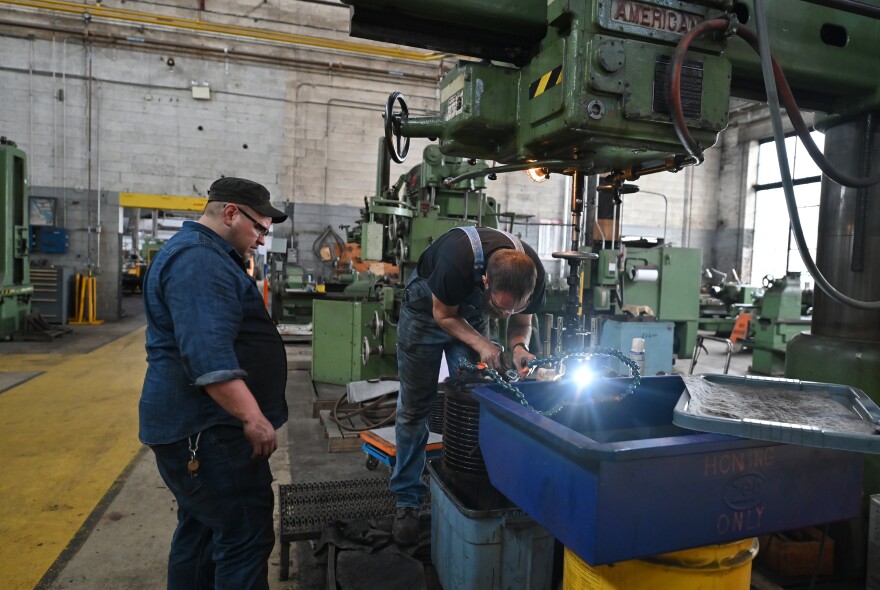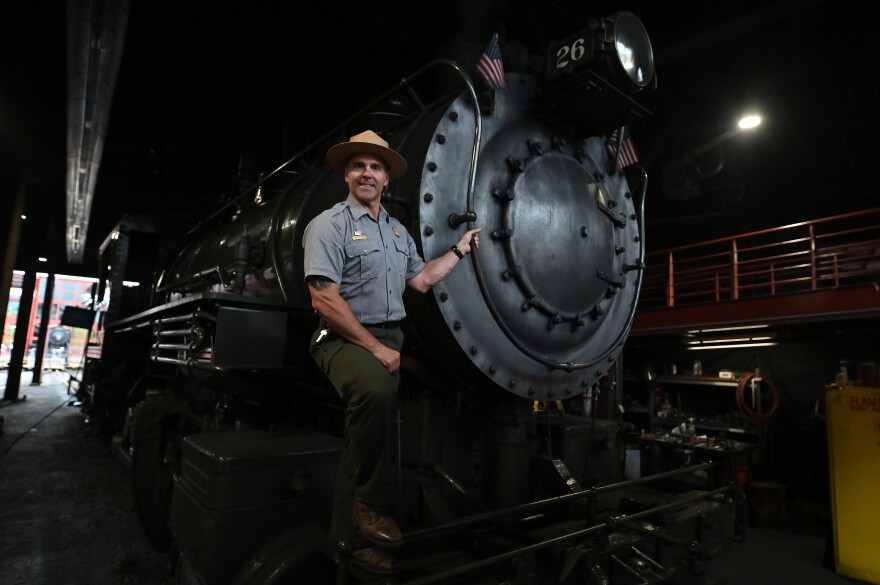Former U.S. Navy SEAL Jeremy Komasz sees his job as superintendent of the Steamtown National Historic Site as his third act and his way to give back.
"In the military, you know, one of the one of the sayings we had was ‘mission first, people always,’ and I try to bring that to the park,” he said.
Komasz is days away from his first Railfest as superintendent. The three-day long event held over Labor Day weekend at the park in downtown Scranton celebrates railroading's past, present, and future with activities and demonstrations. The weekend also will mark the 30th anniversary of the park's grand opening.
He stepped into the role of superintendent on Jan. 19, making a move out of the private sector defense industry and back into service to the American people.
Komasz is preparing for Railfest 2025, but acknowledges even now he's not fully sure what to expect.
"I think that one of the things I've been told is doesn't matter what we tell you about it, you're gonna have to see it to believe it,” he said.
That sentiment mirrors his experience with the park.
Komasz always had a positive experience at the country’s national parks — but always as a visitor. He walked around Steamtown before saying yes to the position.
"It all is, and was new to me as of January of this year,” he said.
Komasz replaced Cherie Shepherd in the role. He views Steamtown as a unique part of the nation’s history that few people know about.
"There is nothing that compares to the effect that railroading had on the United States,” he said.
Komasz was recently reminded of something founding father Thomas Jefferson said after he completed the Louisiana Purchase in 1803.
"He said that it would be 1,000 years until we settled this land. Took us about 30. The reason it took 30 was because of railroading,” he said. "So if you want to really look at American history and something that really changed the tide of it, railroading is a good place to start.”
A push to Scranton

What’s not new to Komasz is Scranton. In 2022, he began dating his now-girlfriend, who is a Scranton native and resident. Close to the same time, he was at an event at Gettysburg National Military Park. A former superintendent of the park asked him if he was interested in being a park superintendent.
"My initial response was absolutely not. I thought I was happy in my cushy business job,” he said.
The contact was persistent.
“He then continued to network me with people in the park service to learn more about kind of the options in the National Park Service, coming into a leadership position, being able to run the national park based on the leadership experience that I had from the business world as well as from the Navy,” he said.
Komasz is 51. He knew he would eventually leave the business world and retire from the Navy.
"But I knew I wasn't done, kind of giving back,” he said.
He started applying for park service jobs. He said the universe pushed him to Scranton.
"My mentor, one day, sends me the USA Jobs listing for the superintendent position at Steamtown," he said.
He had to look up where the park is.
"I had no idea, just like too many people, right, I was like, it's in Scranton, Pennsylvania,” he said.
The southern New Jersey native was living in Cleveland at the time. Now, his home is in back in the northeast in North Scranton.
"I've enjoyed everything that the area has to offer, and really has been a great decision. You know, personally and professionally for me,” he said.

Three buildings down
One of his first missions at the park was to assess the three buildings that were closed down.
The facilities were connected to a central heating system, which Komasz said suffered a “catastrophic” failure. The fire suppression and the air conditioning systems were shut off and drained — without heat, they had to keep the pipes from freezing.
Before Komasz arrived, a decision was made to keep the air conditioning off. They’d just have to drain the system again come winter.
"When I got here, I realized that it would be better to do the double work and have a few more buildings open than have three buildings closed,” he said.
Komasz looked at the park’s resources.
"The American people own this park, we want them to come experience it,” he said.
They tested the fire suppression system and air conditioning. It works despite being turned off for three years.
They opened up the visitors’ center.
“Now, there's a place for people to come to be greeted. That's where the restrooms are. And people like restrooms. It is a well-known fact in the park service that the most asked question in the National Park Service is, where is the restroom,” he said.
They’re working on contracts to replace the system. Instead of every building connected to one central system, each building will have its own.
"So that we don't have a major failure,” Komasz said.
The theater building is still closed. They’re debating what to do with that space.
“If you look at how the visitor experience has changed from 1995 when we opened, until now, most people don't want to sit down in a big theater and watch a movie about the park. They want to go experience the park.” he said.
They can show the movie on a smaller screen in the park.
"Nothing is inexpensive, and 30-year-old buildings are really, really expensive to fix. So those are the things that we're balancing,” he said.

Changing American history

Scranton officials and community members in the late '80s pushed to move predecessor Steamtown USA's large collection of steam equipment from Bellows Falls, Vermont, to Scranton. The first trains made their way to the Electric City in 1984.
Then-U.S. Rep. Joseph McDade was instrumental in getting the park service to take over the site, even securing $66 million for the project.
The National Historic Site opened on July 1, 1995. The park’s mission is to preserve the steam era of railroading from 1850 to 1950.
Over the last three decades, there were moments when the fate of the park at the federal level was unclear.
In February, five out of seven probationary employees were let go through Department of Government Efficiency (DOGE) cuts. A large rally was held in downtown Scranton for the park and other National Park Service sites.
At the same time, Steamtown remains a functioning railyard, with museum exhibits juxtaposed against working freight trains.
"We have trains from the Delaware-Lackawanna Railroad passing through federally owned train tracks every single day, multiple times a day,” he said.

'Come see us and say hi'
The roughly 62-acre park on Cliff Street in Scranton is home to 4.6 million artifacts. There is no entrance free to get into the park, which hosts about 70,000 visitors a year. There is a charge for short train rides and other events coordinated by the Iron Horse Society, a nonprofit that supports the park.
As superintendent, Komasz oversees 51 full-time staff members who work in four branches at the park: interpretive, maintenance staff, administrative and railyard operations.
At least two staff members have been there since before the park officially opened, he said.
Scranton is considered the park’s "Gateway Community." The designation goes to communities that are within one mile of a national park and are part of the nation’s travel and tourism industry.
But Komacz feels that every community along the rail lines the park’s trains travel over are gateway communities for the park. He plans to partner more with the communities that are home to small historic train stations in Lackawanna County and the Poconos.
"There is a large economic impact that a national park has on the local area. So we want to make sure that we continue to highlight and continue to partner with the city and the county and the surrounding area to show that impact and then increase that impact," he said.
Still, Komasz thinks it's easier to attract people from out of the area to Steamtown, than those from in town.
"The harder outreach is the people … who are from here,” he said.
As superintendent, he takes time to ride the trains, like a mid-August ice cream train ride to Gouldsboro, and meet with people.
He’s had people say to him: “that park over there, right? I remember that, huh? I've never been there” or “I haven't been there since my kids were four years old, you know, wait, that's still there.”
“I want people to know that the park is here. I want people to come see us and come say 'hi' and bring your family and your friends and your kids," Komasz said.

Komacz said railroading can touch almost every piece of American history, which makes Steamtown special and different than many of the other 433 parks in the system.
"I want everybody to know that the park is here. We're not going anywhere. We've been here for 30 years plus, and right now what we're looking at is what is the next 30 years of Steamtown look like, and how do we get there?” he said.
IF YOU GO
WHAT: Railfest 2025, celebrating railroading and the 30th Anniversary of the Steamtown National Historic Site grand opening
WHEN: Aug. 29 to 31, 9 a.m. to 5 p.m.
WHERE: Steamtown National Historic Site, Scranton
SPECIAL EVENT: New for Railfest there will be a discussion panel on Friday from 3 to 4:30 p.m. with experts from across the railroad industry.
FOR MORE DETAILS: Visit https://www.nps.gov/stea/planyourvisit/railfest-at-steamtown-national-historic-site.htm


